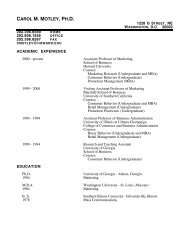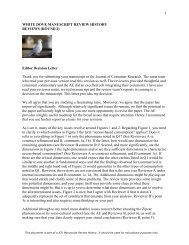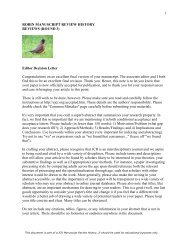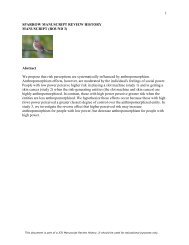Why Happiness Helps You See the Big Picture - Journal of ...
Why Happiness Helps You See the Big Picture - Journal of ...
Why Happiness Helps You See the Big Picture - Journal of ...
Create successful ePaper yourself
Turn your PDF publications into a flip-book with our unique Google optimized e-Paper software.
Copyright <strong>Journal</strong> <strong>of</strong> Consumer Research 2008.<br />
Preprint (not formatted or copyedited).<br />
Do not quote or cite without permission.<br />
10<br />
product benefits using a concrete, immediate frame (e.g., ―ensure your health today‖).<br />
After viewing <strong>the</strong> advertisement, participants indicated on a seven-point scale how likely<br />
<strong>the</strong>y were to buy <strong>the</strong> orange juice (1 = not likely to buy, 7 = very likely to buy). In<br />
addition, <strong>the</strong>y indicated how much attention <strong>the</strong>y paid to <strong>the</strong> ad and how arousing <strong>the</strong> ad<br />
was using two seven-point scales (1 = paid little attention, not at all arousing; 7 = paid a<br />
lot <strong>of</strong> attention, very arousing). Then, <strong>the</strong>y responded to some additional questions,<br />
including demographic measures.<br />
Results and Discussion<br />
Manipulation checks. A 3 mood × 2 construal ANOVA conducted on <strong>the</strong> selfreport<br />
measure <strong>of</strong> mood revealed a main effect <strong>of</strong> mood (F(2, 84) = 9.13, p < .05).<br />
Participants who provided <strong>the</strong>ir first associations with each <strong>of</strong> ten positive words<br />
indicated that <strong>the</strong>ir mood was more positive than those who provided <strong>the</strong>ir first<br />
associations with each <strong>of</strong> ten neutral words or each <strong>of</strong> ten negative words. No o<strong>the</strong>r<br />
effects were significant. Planned contrasts indicated that participants in a positive mood<br />
reported feeling more positive (M = 4.83) than participants in a neutral mood (M = 4.13;<br />
t(84) = 2.61, p < .05). Fur<strong>the</strong>rmore, participants in a negative mood (M = 3.52; t(84) =<br />
2.02, p < .05) reported feeling less positive than participants in a neutral mood.<br />
A mood × construal ANOVA conducted on attention to <strong>the</strong> advertisement showed<br />
that nei<strong>the</strong>r <strong>of</strong> <strong>the</strong> main effects nor <strong>the</strong> interaction was significant. This suggests that<br />
different groups <strong>of</strong> participants did not attend to <strong>the</strong> two advertisements differently (all Fs<br />
< 1). A mood × construal ANOVA conducted on <strong>the</strong> arousal measure also showed that<br />
nei<strong>the</strong>r <strong>of</strong> <strong>the</strong> main effects nor <strong>the</strong> interaction was significant (all Fs < 1).<br />
Purchase intent. The mood × construal ANOVA conducted on <strong>the</strong> purchase-intent<br />
measure revealed only an interaction (F(2, 84) = 5.25, p < .05). No o<strong>the</strong>r effects were<br />
significant (mood: F(2, 84) = 1.66, p > .15; advertisement: F(1, 84) = 2.15, p > .10). As<br />
we expected, when participants viewed <strong>the</strong> abstract advertisement, those in a positive<br />
mood indicated higher purchase intent (M = 4.11) than those in neutral mood (M = 2.76;<br />
t(84) = 2.55, p < .05) and those in a negative mood (M = 2.75; t(84) = 2.31, p < .05). In<br />
contrast, when participants viewed <strong>the</strong> concrete advertisement, those in a negative mood<br />
indicated higher purchase intent (M = 4.45) than those in a neutral mood (M = 3.40; t(84)<br />
= 1.69, p < .05) and those in a positive mood (M = 3.41; t(84) = 1.72, p < .05).<br />
These data show that respondents in a positive mood prefer products that confer<br />
future benefits. Note that our effects cannot be explained by heuristic processing or by<br />
relying on <strong>the</strong> notion that a positive (vs. negative) mood reduces attention to tasks at<br />
hand. First, experiments 1a and 1b employed standard tests <strong>of</strong> construal level using<br />
Vallacher and Wegner’s (1989) questionnaire and demonstrated correspondence between<br />
cues/mood and construal level, and <strong>the</strong> literature (Trope et al. 2007) argues that abstract<br />
construal or performance in <strong>the</strong>se tests does not correspond with heuristic processing.<br />
Second, <strong>the</strong> results <strong>of</strong> experiment 1b demonstrated that participants were more abstract<br />
when <strong>the</strong>y completed a forced-choice description task than when <strong>the</strong>y completed an<br />
open-ended description task. Presumably, making forced choices is easier than generating<br />
activities; <strong>the</strong>refore, if participants were more likely to be abstract in a forced-choice task<br />
than in an open-ended task, <strong>the</strong> data imply that it was more difficult, not easier, to come<br />
up with abstract construal. In addition, if participants preferred to be abstract only as long









